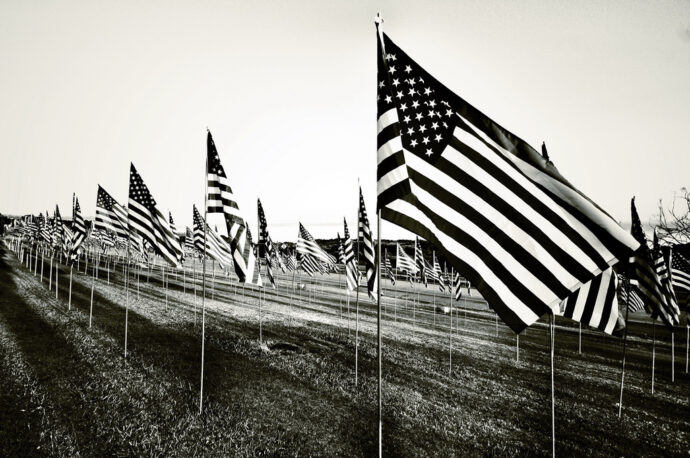As the sixteenth anniversary of the 9/11 attacks approaches, communities from Utica, New York to Sandy, Utah are preparing versions of what has become a new national flag ritual—the commemoration of the lives lost and the reiteration of American strength and unity in the wake of those attacks via the display of large numbers of United States flags.
The general pattern for these rituals involves one flag displayed each of those who lost their lives on 9/11. While this often leads to the use of smaller than standard-size flags (in the Village Green of Winnetka, Illinois this year, for instance, 2,977 flag of 8’ by 12” inch each will be planted, an increase from the 4” by 6” flags used in previous years), some municipalities employ full-size flags, resulting in a spectacular scene. Oak Brook, Illinois, another Chicago suburb, is erecting a “Healing Field” of evenly spaced flags, covering two and a half acres.
One immediate goal with such an arrangement (as with analogous displays of white crosses in protest of abortion or the array of wooden angels to commemorate the victims of the Sandy Hook Elementary School massacre) is to convey the enormity of the loss of life, to make otherwise abstract numbers visible. In the Oak Brook commemoration, each flag has attached to it a brief biography of the person killed, with color-coded ribbons differentiating civilians and flight crews from first responders. Orlando, Florida, on the logic that far more were injured in both visible and “invisible” ways, has opted to erect 250,000 flags.
It is not death that is primary here, in any case. The flag’s sacrality, to use an oft-invoked religious term for the societal roles this emblem plays, is linked to its resistance of a single straight meaning. The flag’s power resides in its excess of meaning, as in these 9/11 rituals, where the flag signifies loss, sacrifice, and mourning, but also resilience, unity, strength, an unbroken trajectory from the mythic mists of the Founding to the struggles of the present and the undimmed dream of an American yet-to-be-realized. As Justice John Paul Stevens has said,
the flag uniquely symbolizes the ideas of liberty, equality, and tolerance — ideas that Americans have passionately defended and debated throughout our history. The flag embodies the spirit of our national commitment to those ideals…. To the world, the flag is our promise that we will continue to strive for these ideals. To us, the flag is a reminder both that the struggle for liberty and equality is unceasing and that our obligation of tolerance and respect for all of our fellow citizens encompasses those who disagree with us — indeed, even those whose ideas are disagreeable or offensive.
A political symbol, certainly, it remains resolutely nonpartisan. As Chief Justice William Rehnquist has written, “It does not represent the views of any particular political party, and it does not represent any particular political philosophy.” The flag is a multivalent symbol, open to myriad meanings.
Successful symbols, as anthropologist Gananath Obeyesekere argued years ago, are malleable things, adapted to various needs by the user yet remaining intelligible to the broader culture. As Obeyesekere put it, robust symbols were characterized by “syntactic looseness and ambiguity.”
Obeyesekere also argued that academics have a knack—even an obsession, at times—for conventionalizing symbols, rendering the thing “narrowed down and given limited and rigid meaning” via their own interpretations, as witness Carolyn Marvin and David W. Ingle’s Blood Sacrifice and the Nation: Totem Rituals and the American Flag which argues that the flag is a totem for the nation, helping to imbue military deaths with meaning while also playing important roles in the marketplace and carnival and facilitating fertility rites involving reunions between soldiers and their spouses. The book has some fascinating tidbits in it (who knew that “Old Glory” condoms donate a portion of profits to AIDS related services and include, in each box, a “pledge” that “it is patriotic to protect and save lives”?), but such tidbits do little to shore up the thesis and, on the contrary, point to the wildly protean meanings the flag is capable of conveying.
A fixture at the ball field as well as the courtroom, the military funeral and the school, marked through such “daily sacraments” as the Pledge of Allegiance and its raising, lowering, and flying at half-mast, the flag, as Peter Gardella has argued, is a sacred because “[e]ach flag sacramentally contains the land, people, government, and spirit of the United States.”
I don’t understand that any better than the claim about fertility rites, nor can I claim to grasp the meaning of Justice Byron White’s statement that “The flag is itself a monument [akin to the Lincoln Memorial], subject to similar protection.” I’m likewise baffled by the citizen quoted in a Time magazine article from 1970, quoted in turn by Gardella, who said, “I see the flag as I see God: a supreme being,” and the perhaps even odder statement, from the same source, by evangelist Billy Graham, that the Stars and Stripes is “our Queen.”
But what all those quotes seem to be struggling to articulate is the power the flag has, a power Jonathan Ebel has described in terms of indeterminacy. Its “sacred status” can be traced back to multiple sources, linked to myriad claims about what American means and what its values are. The flag can signify the blood lost on foreign soils or the promise of equal justice under the law at home, can stand for collective sacrifice or collective hope—can be one person’s “supreme being” and another’s “Queen,” even.
As Marc Leepson’s Flag: An American Biography tells the story, the American flag, while approved in 1777 largely for the protection of American ships at sea, was not widely displayed by civilians until the Civil War. Once the flag was lowered over Fort Sumter, flags rose over houses and wagons and even hats.
The next major watershed in civilian relations to flags was 9/11. Gardella writes that “According to the largest flag manufacturer in the United States, Annin & Company, more flags were sold in the ten days following September 11 than in the whole year before. Orders became backed up until midsummer of 2002. Wal-Mart reported selling 118,000 flags in a single day.” The event even inspired new designs, from the well-known “Flag of Honor” and “Flag of Heroes” featuring the names of the dead to the lesser-known “Thunder Flag,” or Flags specifically commemorating Flight 93, the attack on the Pentagon, or the World Trade Center towers. Such mass-produced flags unique 9/11 artifact flags, such as the one famously raised over Ground Zero by New York City firemen or similarly distinct memorial flags like the giant, 75-pound “Patriot Flag” which is on tour around the country to honor the 9/11 victims.
The commemorative fields of flags that demarcate local 9/11 memorial rituals, however, feature most prominently the iconic Stars and Stripes, and, while the number of flags arranged is meant to be awe-inspiring, alternately horrifying and uplifting, the flags themselves are common objects, flags any participant in these rituals could own and wave and display at their own home. Indeed, some memorials will be selling the flags used. There is nothing rare or unattainable in these displays; the commonness of the flag exemplifies one of this country’s values, a popular sovereignty in which all citizens participate. The flag, as symbol, can be seen as functioning something like a reversal of the national motto of “e pluribus unum,” for from one emblem we find infinite significances.
The flag acts, to offer a rough analogy, something like a window into the roiling and complicated, multifarious heart of the country itself, at turns glorious and shameful, always falling short of yet also repeating and reaffirming commitment in an unparalleled set of political and ethical ideals. Or, to polish the analogy a bit, the flag, in its ceaseless variety of meanings, its simultaneous ubiquity and sacredness, acts something like a mirror, showing us the United States that we, as citizens, are.
Consideration of the flag and its function, then, is not some egg-headed, ethereal academic quest; it is an urgent prompt for civic self-examination, one that should be regularly on the minds of all of us who bear such pressing duties to this political experiment of which we are a part. This, indeed, is something worth thinking about during whatever 9/11 commemoration ritual is taking place near you.





